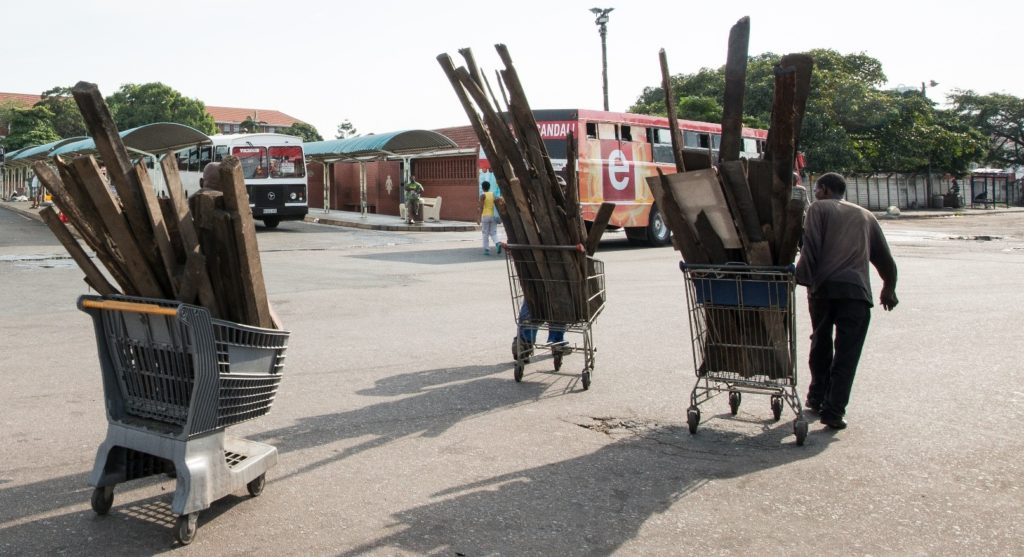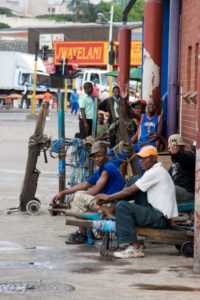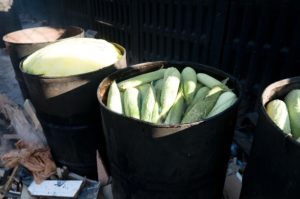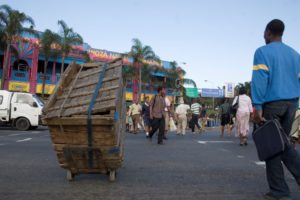 Wood salvagers transporting their materials to the mealie cooks. Photo: Angie Buckland by permission Asiye eTafuleni.
Wood salvagers transporting their materials to the mealie cooks. Photo: Angie Buckland by permission Asiye eTafuleni.
Sarah Heneck
Growing up in a South African city, the informal economy is something that one cannot help but be aware of, however, I have only recently been exposed to the depth and complexities of this undervalued sector of our economy which provides livelihoods to so many people.
My first visit to Asiye eTafuleni (AeT), which lasted 3 days in October 2018, involved a tour of Warwick Junction; a bustling, vibrant hub of informal activity, as well as a tour of the informal recycling facilities and the mealie cooking facilities (whose custodians make the world’s best braai’ed mealies!), accompanying the team for a day of fieldwork in Isiphingo and attending a design-based meeting. I thoroughly enjoyed every experience and I came home with a lot of new knowledge and a very inspired soul.
 One of the things that struck me most was the amount of jobs being undertaken in the market that I would have never known existed if it wasn’t for the insider knowledge that was passed on to me by the AeT team. The informal traders are one of the most visible elements of the informal economy, but they have many other “invisible” informal workers who help them function the way they do. For example, wheel-barrow pushers help the traders to transport their goods to and from their trading posts – they are known as “barrow operators” and there are hundreds of them who deftly make their way through crowds of people with hardly anyone noticing.
One of the things that struck me most was the amount of jobs being undertaken in the market that I would have never known existed if it wasn’t for the insider knowledge that was passed on to me by the AeT team. The informal traders are one of the most visible elements of the informal economy, but they have many other “invisible” informal workers who help them function the way they do. For example, wheel-barrow pushers help the traders to transport their goods to and from their trading posts – they are known as “barrow operators” and there are hundreds of them who deftly make their way through crowds of people with hardly anyone noticing.
Image Right – Barrow operators taking a well-deserved break. Photo: Gerald Botha by permission Asiye eTafuleni.
 Braai’ed or boiled mealies can be found in numerous places throughout the market but the sellers who are seen on the street are only one link in the chain; there is a supervisor who buys the mealies, the cooks who prepare the mealies in large vats of boiling water, the people who help the cooks to empty the water once the mealies are cooked and finally, upon completion of the cooking process, the mealies are given to the distributors who either sell them as they are or add a deliciously smoky flavour to them via a braai.
Braai’ed or boiled mealies can be found in numerous places throughout the market but the sellers who are seen on the street are only one link in the chain; there is a supervisor who buys the mealies, the cooks who prepare the mealies in large vats of boiling water, the people who help the cooks to empty the water once the mealies are cooked and finally, upon completion of the cooking process, the mealies are given to the distributors who either sell them as they are or add a deliciously smoky flavour to them via a braai.
Image Left – Mealies waiting to be boiled. Photo: Andrew Griffin by permission Asiye eTafuleni.
Traditional medicine traders, to which an entire portion of the market is dedicated, pay strong men to crush up some of their herbs – like a human scale pestle and mortar, they use long poles and buckets, and a huge amount of upper body strength. Some of the bovine head cooks will pay “freelance cleavers” to take the meat off the bovine skulls, before they prepare the traditional meal for the people who come for lunch at the market. Informal employment also comes in the form of “touters” who make it clear to passers-by where the temporary facility in which the bovine head meat is being served, is situated.
Image Left: Carpenter creating palettes on the streets of Warwick Junction. Photo: Gerald Botha by permission Asiye eTafuleni. Image Right: Barrow operator transporting produce to traders. Photo: Gerald Botha by permission Asiye eTafuleni.
The taxi’s are another vital element of Warwick Junction; the “visible” drivers are employed by the taxi owners and the drivers in turn employ taxi-washers and “kerb-side mechanics” to service their vehicles. These intricacies make Warwick Junction the dynamic place that it undoubtedly is. What appears to be illegible activity to those on the outside, is actually a very well-organised system which not only provides employment to a vast number of people, but also an essential service to the approximately 500 000 Durban residents which pass through it on a daily basis!
My 3-day visit left me itching to learn more and 3 months later I am now a member of the AeT team. I think that one of the most important aspects of urban living is learning to value informality. Once we regard something as being of high value, we are one step closer to supporting it and by supporting it we have the potential to help it thrive. The informal economy is often seen as something which should be formalised, modernised or eradicated when in fact it should be celebrated as an efficient, well-functioning, livelihood supporting network.



